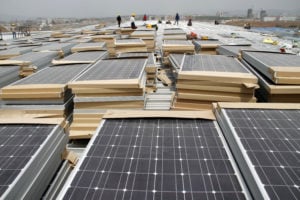China has consolidated itself as one of the largest foreign investors in Brazil since 2010, as a study recently published by the China-Brazil Business Council (CEBC) shows. It rivals the US and European countries, who have been established as foreign investors in Brazil for decades. Brazil is the main destination for Chinese investments in South America, receiving US$66.1 billion, equivalent to 47% of the total amount invested, in the decade up to 2020.
47%
of all Chinese investment in Latin America has flowed to Brazil
Between 2007 and 2020, Chinese companies made large investments in the electricity sector, which attracted 48% of the total amount, followed by oil extraction (28%), and mining (7%). If we analyse investments by number of projects, not by value, although the electricity sector is still on top of the ranking, with 31% of the total, the manufacturing sector takes second place, with 28%, followed by information technology and agriculture, with 7% each, and financial services, with 6%.
The distribution of Chinese companies’ investments across all regions of Brazil is also noteworthy, with confirmed projects in 23 of 27 states. However, the state of São Paulo attracted almost a third of all projects. What is most striking is the speed with which these newcomers have managed to enter practically the entire country, taking little over a decade to leave a legacy of factory construction, infrastructure projects and acquisitions of a variety of companies.
Annual flows of Chinese investments to Brazil, however, have fluctuated. At US$13 billion, the year 2010 marked the peak. Since then, there have been decreases and occasional increases, which is also reflected in the number of projects, which reached a maximum of 32 in 2018.
Between 2019 and 2020, the situation was no different despite expectations about the future of Chinese investments in Brazil under Jair Bolsonaro. The president had expressed reluctance to enter into partnerships with China and even claimed that the Chinese would be “buying Brazil”. Despite this, what you saw in practical terms was a movement with more continuity than ruptures.
In 2019, the two countries re-established the Sino-Brazilian High-Level Commission for Consultation and Cooperation (COSBAN), led by vice president Hamilton Mourão. In addition, Presidents Bolsonaro and Xi Jinping exchanged state visits, highlighting the gap between the former’s critical discourse and the realities of enduring bilateral dialogue.
In that year, the value of confirmed Chinese investments in Brazil grew 117%, totalling US$ 7.3 billion. This was despite a 8.2% drop in China’s foreign direct investments worldwide in the same period. For the first time, Brazil’s Northeast attracted the largest number of Chinese projects of any region — 34% of the total — and the highest amount in contributions, with more than half of the capital invested.
2020
saw a 74% drop in Chinese investment in Brazil
In 2020, Chinese investments fell by 74% to US$1.9 billion, the lowest amount since 2014. This less dynamic scenario was not inconsistent with investments worldwide. It reflected the challenges of the Covid-19 pandemic. According to the United Nations Conference on Trade and Development, foreign investments globally reached US$1 trillion in 2020, a drop of 35% compared to the previous year and a figure almost 20% lower than that recorded after the 2009 global financial crisis. Brazil saw a 50% drop in foreign investments, according to data from the Central Bank.
It is fundamental that governments, the private sector and academia continue to seek to understand China’s rise throughout the world
Despite occasional ups and downs in trade, the most important thing to understand is the long-term nature of Chinese investments in Brazil. The development of projects not only creates jobs in the country, including in regions far from large urban centres, but also modernises infrastructure, stimulates the economy and creates connectivity between industries.
In order for Brazil to maximise its gains from attracting new Chinese projects, it is fundamental that governments, the private sector and academia continue to seek to understand China’s rise throughout the world, not only as an investor capable of contributing large volumes of capital, but also as a technological power. In the Sino-Brazilian relationship, there is still potential to go far beyond well-established sectors, with cooperation, for example, on ports, transportation and logistics, as well as in the new frontiers of information technology.









